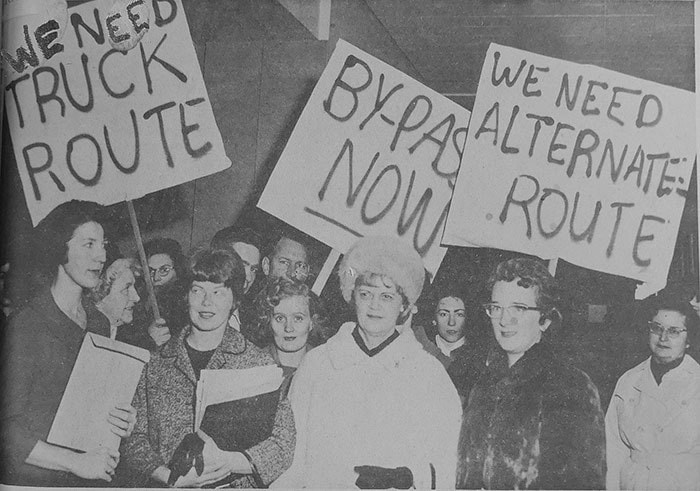By Morgan Ostler
The history of Campbell River’s struggle for the four lane highway to Nanaimo couldn’t be complete without giving full appreciation to the local Chamber of Commerce for its role in the achievement.
In fact, the 36-year wait was overshadowed by the chamber’s early records that show there was an outcry from its members as far back as 1930 to pave the road between Campbell River and Courtenay. The existing road followed the route of the old logging vehicles and remained a mud and gravel road until it was at last paved in 1953.
With the twists and turns on the upgraded road the accidents mounted over the years and the route became known as the “Highway of Death” by Island residents.
Up-Island residents were in despair over the deadly statistics. In the winter of 1964, a seven-year-old girl was killed by a speeding motorist near Rotary Beach. That brought the winter toll to 13 deaths just in the local area.
The accident galvanized a group of young mothers to form a protest group which eventually became known as the SMASHing Grannies. This resulted in the group’s leaders, Sandra Baikie and Morgan Ostler, along with 40 supporters, to call for a meeting with the Minister of Highways, Phil Gaglardi. Armed with statistics and petitions, the women eventually wrung a commitment from the minister that construction would begin within the next five years.
With the change in government from Social Credit to a short term for the NDP and then back to the Socreds between 1965 and 1984, there was little hope that the presiding government would listen to the pleas for a new highway north of Nanaimo.
Campbell River at that time was considered the fastest growing community in the province. “Our growth is putting a strain on the town’s infrastructure,” stated Chamber Chairperson, Ron Hagerman, in 1992.
His board prepared an extensive document for the Ministry of Highways outlining the negative economic impact the crowded highway was having on all communities north of Nanaimo.
With the NDP in office, Campbell River’s Chamber was determined to keep the momentum for a new roadway high on the new government’s agenda. Chamber members organized a cavalcade to Victoria.
A petition supporting a new road was quickly filled with 21,000 signatures, buses were organized and banners painted. B.C. Road Builders offered its support.
The boisterous rally had a huge impact on the highway ministry but it was still a long wait before Premier Mike Harcourt arrived in Campbell River in 1993, flanked by his Island cabinet ministers, and announced that construction would begin in 1996. While the building of the highway was underway, the Chamber had to rally again and again, first to demand that the highway remain four lanes from Courtenay to Campbell River and, secondly, to fight for inclusion of the safety barriers.
On Sept. 7, 2001, 36 years after the first protest began, the Chamber organized a huge party at the corner of the new highway and the Jubilee Parkway. A Times-Colonist reporter who covered the event said it was probably the longest lobby on record in the history of British Columbia.
Learn more about the lobby for the Inland Island Highway at a talk and slide show with Morgan Ostler Saturday Sept. 24 at 1 p.m. at the Museum at Campbell River.
